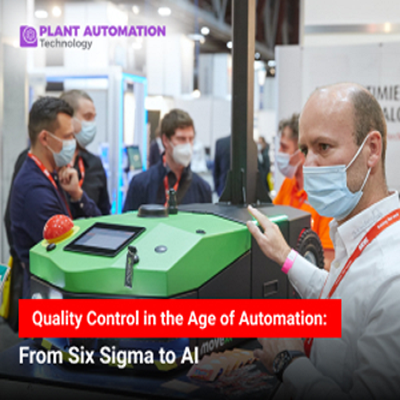Quality Control in the Age of Automation: From Six Sigma to AI

In an era dominated by technology and automation, the realm of quality control has undergone a significant transformation. From traditional methodologies like Six Sigma to the integration of cutting-edge Artificial Intelligence (AI), businesses are now equipped with an array of powerful tools to ensure high standards of product and service excellence. Let's delve into the evolution of quality control and understand how it has adapted to the demands of the modern age.
The Era of Six Sigma
Emerging from manufacturing practices in the mid-1980s, Six Sigma swiftly emerged as a fundamental pillar of quality control methodologies. At its core, it strives to minimize defects and discrepancies, aiming for a standard deviation of less than 3.4 defects per million opportunities. By utilizing statistical analysis, process enhancements, and rigorous quality standards, Six Sigma cultivated a culture of perpetual advancement within organizations. It emphasized the identification of the root causes of defects and the application of data-backed remedies, thus amplifying overall effectiveness and customer contentment.
Transition to Automation
With the advent of automation, the traditional Six Sigma approach has evolved to accommodate the intricacies of modern production systems. Automation has enabled the streamlining of processes, thereby reducing human errors and increasing productivity. By incorporating automated machinery and robotics, industries have minimized the scope for variability, leading to higher precision and faster production cycles.
Incorporating AI into the Equation
With the continuous expansion of the digital sphere, the assimilation of AI has transformed how businesses tackle quality control. AI-driven systems possess the capacity to analyze extensive datasets instantaneously, enabling the detection of patterns and irregularities that may elude human observation. Through machine learning algorithms, AI can anticipate potential defects and propose proactive measures, thereby preemptively addressing issues before they manifest.
Benefits of AI in Quality Control
One of the significant advantages of AI in quality control is its ability to adapt and learn from data inputs. Unlike traditional methods that rely on fixed parameters, AI algorithms can continuously evolve based on the feedback and data they receive. This adaptive nature enables them to refine their predictions and optimize processes over time, leading to increased accuracy and reduced downtime.
Moreover, AI-driven quality control systems can operate 24/7 without fatigue, consistently monitoring production lines and swiftly identifying deviations from the standard. By swiftly detecting anomalies, AI minimizes the risk of defective products reaching consumers, thus safeguarding a company's reputation and customer trust.
Addressing Challenges and Ensuring Ethical Implementation
While AI presents significant advantages, its incorporation into quality control is not exempt from challenges. Safeguarding data integrity and preserving the confidentiality of sensitive information is critical to prevent breaches and maintain consumer confidence. Additionally, ethical considerations pertaining to AI's decision-making mechanisms and the potential for biases necessitate thorough supervision to ensure impartial and transparent results.
To mitigate these challenges, companies must prioritize data security measures and invest in robust encryption protocols. Additionally, implementing ethical AI frameworks that emphasize transparency, fairness, and accountability is crucial in upholding responsible AI practices.
The Human Touch in Automated Quality Control
While AI has significantly enhanced the precision and efficiency of quality control processes, the human element remains indispensable. Human expertise and intuition play a vital role in interpreting complex data patterns and making crucial decisions that require contextual understanding. Therefore, the collaboration between AI and human professionals is essential to optimize quality control outcomes.
Furthermore, fostering a culture of continuous learning and skill development among employees is crucial to ensure that they can adapt to the evolving demands of an automated landscape. Encouraging a proactive approach to embracing technological advancements will empower employees to leverage AI tools effectively, enhancing their overall productivity and job satisfaction.
The Future Landscape of Quality Control
Looking ahead, the future of quality control lies in the seamless integration of AI with human ingenuity. As AI continues to evolve and adapt, its potential to transform quality control processes will only expand. However, it is imperative for organizations to strike a balance between technological advancements and human expertise to harness the full potential of automated quality control while upholding ethical standards and data security protocols.
Advancements and Integration of IoT
In the realm of quality control, the integration of the Internet of Things (IoT) is set to redefine the manufacturing landscape. IoT-enabled sensors and devices offer real-time monitoring and data collection, providing comprehensive insights into the performance of machinery and production processes. By harnessing IoT, businesses can proactively identify potential issues, optimize resource allocation, and facilitate predictive maintenance, thus ensuring seamless operations and a reduction in downtime.
Elevated Customization and Tailored Experiences
Through the integration of AI-powered quality control, businesses can adeptly meet the burgeoning consumer appetite for customized products and services. By scrutinizing consumer behavior and preferences, AI algorithms can direct the production process to generate personalized offerings that deeply resonate with individual needs. This elevated level of customization not only heightens customer satisfaction but also cultivates deeper brand loyalty, differentiating businesses in an ever more competitive market.
Regulatory Compliance and Quality Assurance
As industries evolve, regulatory compliance and quality assurance remain vital aspects of the manufacturing process. AI-powered quality control systems can aid in ensuring adherence to industry standards and regulations, mitigating the risk of non-compliance and potential legal ramifications. By continuously monitoring and analyzing production data, businesses can proactively address any discrepancies and maintain a consistent standard of quality that aligns with regulatory requirements.
Promoting Sustainability and Environmentally-Conscious Production
Given the escalating environmental apprehensions, automated quality control can facilitate the adoption of sustainable practices in manufacturing operations. Through optimized resource management and waste reduction, businesses can diminish their carbon footprint and contribute to eco-friendly endeavors. Leveraging AI-driven analytics, companies can pinpoint opportunities for resource conservation and energy efficiency, enabling them to embrace environmentally mindful practices that align with the values of socially responsible consumers.
Overcoming Technological Obsolescence
As technology continually reshapes the landscape of quality control, businesses must proactively address the hurdles presented by the possibility of technological obsolescence. Regular updates and advancements to AI systems are critical to remain current with the latest developments and seamlessly integrate new technologies. Furthermore, fostering a culture of innovation and adaptability within organizations will empower businesses to anticipate and embrace emerging technologies, allowing them to stay ahead in an ever-evolving digital environment.
By embracing the potential of AI, IoT, and sustainable practices while addressing challenges related to compliance and technological obsolescence, businesses can establish themselves as pioneers in the age of automated quality control. The amalgamation of human expertise and technological prowess will pave the way for a future where quality control not only drives operational efficiency but also fosters sustainable growth and innovation.
Conclusion:
In conclusion, the synergy between traditional methodologies like Six Sigma and the integration of AI has redefined the landscape of quality control in the age of automation. By leveraging the benefits of both approaches, businesses can ensure streamlined production processes, minimize defects, and deliver products and services that consistently meet or exceed customer expectations. Embracing this amalgamation of human and technological capabilities will pave the way for a future where quality control is not just a standard, but a hallmark of excellence and innovation.






